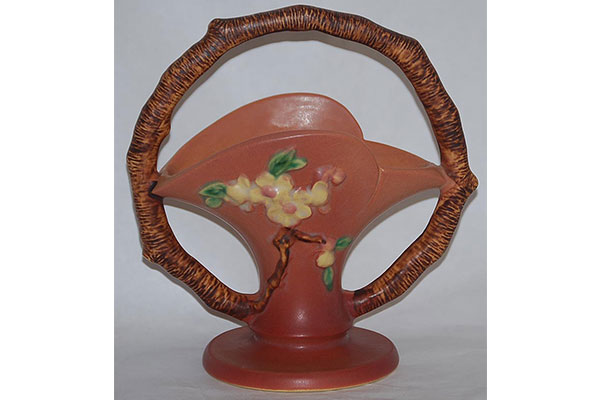
Roseville Apple Blossom
It’s only been in the recent past that collectors of Roseville Pottery began acknowledging that damage is sometimes inevitable. For many years, if there was any damage at all, collectors would pass on those pieces. Today, however, sellers who provide disclosures and “play fair” are far more likely to make a sale of their damaged Roseville pottery pieces. Interestingly, damage or imperfections made during the making of the pottery only adds to the personality of the piece and ensures its originality. It’s the damage incurred after it left the factory that had so many collectors saying, “No thanks”.
According to Mark Bassett’s “Introducing Roseville Pottery” (2nd Ed.), there are generally two classifications of damage specific to Roseville Pottery. The first and less problematic is what’s known as a “glaze chip”. It’s described as a “chip so small that it is not noticeable from a distance of about two to three feet away. As the term implies, a glaze chip should not involve any damage to the clay body of the piece – only to the glaze itself”. Further, these slight damages are equated in size by other easily referenced items such as “a grain of rice” or “the head of a straight pin”.
The second classifications are generally chips deep enough to affect the pottery itself. Hairline cracks also are included in this designation since it potentially affects the pottery piece in its totality. It’s the restoration efforts – or even the lack thereof- many collectors object to. Some don’t mind the professional restoration efforts that include a careful application of epoxy cement and acrylic paint. Both these materials can be easily undone with acetone (nail polish

Roseville Morning Glory
remover). Others, however, believe damage should be left as-is either because it allows a more honest disclosure or because they feel that like all of us mere humans, imperfections are inevitable with age.
If you have any damaged pieces that you acquired, could the damage have been a deal-breaker? Were you afforded a full disclosure? Would you have purchased it anyway had the damage been disclosed (if it wasn’t)? Let us know your thoughts on damage and your art pottery collection. Drop us a line, follow us on Twitter or friend us on Facebook.



Thanks for the essay. I operate a small antiques and collectibles restoration studio (www.theastlefordstudio.com) and find that collectors are always willing to have their pottery restored if the rates affordable. Good restoration work should be invisible to the naked eye but a blacklight will always catch the repairs. As you mentioned in the article, the repairs are reversible if the pottery collect opts to go back to an original state. All in all, I’d say most collectors prefer to restore damaged pottery.
Thanks for the essay. I operate a small antiques and collectibles restoration studio (www.theastlefordstudio.com) and find that collectors are always willing to have their pottery restored if the rates affordable. Good restoration work should be invisible to the naked eye but a blacklight will always catch the repairs. As you mentioned in the article, the repairs are reversible if the pottery collect opts to go back to an original state. All in all, I’d say most collectors prefer to restore damaged pottery.
Sometimes I think defects in pots can make them more desirable and unusual. Damage is just something that happens by accident, its a shame that pieces cant be appreciated for their beauty alone.
Nine times out of ten I’d pass on piece that has a defect, unless it’s a rare and unusual piece or I just love the piece. In my earlier purchases I didn’t pay as much attention to quality as I do now and felt I was probably take advantage more than once. I always appreciate a seller that provides full disclosure and will also take that into consideration on purchasing.
Sometimes I think defects in pots can make them more desirable and unusual. Damage is just something that happens by accident, its a shame that pieces cant be appreciated for their beauty alone.
Nine times out of ten I’d pass on piece that has a defect, unless it’s a rare and unusual piece or I just love the piece. In my earlier purchases I didn’t pay as much attention to quality as I do now and felt I was probably take advantage more than once. I always appreciate a seller that provides full disclosure and will also take that into consideration on purchasing.